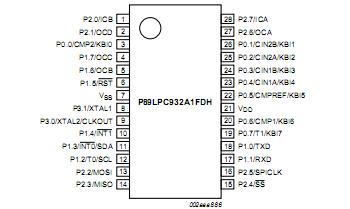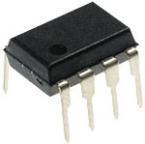Features: 8 kB byte-erasable flash code memory organized into 1 kB sectors and 64-byte pages. Single-byte erasing allows any byte(s) to beused as non-volatile data storage.
256-byte RAM data memory, 512-byte auxiliary on-chip RAM.
512-byte customer data EEPROM on chip allows serialization of devices, storage of set-up parameters, etc.
Two analog comparators with selectable inputs and reference source.
Two 16-bit counter/timers (each may be configured to toggle a port output upon timer overflow or to become a PWM output) and a 23-bit system timer that can also be used as a RTC.
Enhanced UART with fractional baud rate generator, break detect, framing error detection, and automatic address detection; 400 kHz byte-wide I2C-bus communication port and SPI communication port.
CCU provides PWM, input capture, and output compare functions.
High-accuracy internal RC oscillator option allows operation without external oscillator components. The RC oscillator option is selectable and fine tunable.
2.4 V to 3.6 V VDD operating range. I/O pins are 5 V tolerant (may be pulled up or driven to 5.5 V).
28-pin TSSOP, PLCC, and HVQFN packages with 23 I/O pins minimum and up to 26
I/O pins while using on-chip oscillator and reset options.ApplicationA high performance 80C51 CPU provides instruction cycle times of 111 ns to 222 ns for all instructions except multiply and divide when executing at 18 MHz. This is sitimes the performance of the standard 80C51 running at the same clock frequency. A lower clock frequency for the same performance results in power savings and reducedEMI
In-Circuit Programming (ICP) allows simple production coding with commercial EPROM programmers. Flash security bits prevent reading of sensitive application programs.
Serial flash In-System Programming (ISP) allows coding while the device is mounted in the end application.
In-Application Programming (IAP) of the flash code memory. This allows changing the code in a running application.
Watchdog timer with separate on-chip oscillator, requiring no external components. The watchdog prescaler is selectable from eight values.
Low voltage reset (brownout detect) allows a graceful system shutdown when power fails. May optionally be configured as an interrupt.
Idle and two different power-down reduced power modes. Improved wake-up from Power-down mode (a LOW interrupt input starts execution). Typical power-down
current is 1 µA (total power-down with voltage comparators disabled).
Active-LOW reset. On-chip power-on reset allows operation without external reset components. A reset counter and reset glitch suppression circuitry prevent spurious
and incomplete resets. A software reset function is also available.
Configurable on-chip oscillator with frequency range options selected by user programmed flash configuration bits. Oscillator options support frequencies from
20 kHz to the maximum operating frequency of 18 MHz.
Oscillator fail detect. The watchdog timer has a separate fully on-chip oscillator allowing it to perform an oscillator fail detect function.
Programmable port output configuration options: quasi-bidirectional, open drain, push-pull, input-only.
Port 'input pattern match' detect. Port 0 may generate an interrupt when the value of the pins match or do not match a programmable pattern.
LED drive capability (20 mA) on all port pins. A maximum limit is specified for the entire chip.
Controlled slew rate port outputs to reduce EMI. Outputs have approximately 10 ns minimum ramp times.
Only power and ground connections are required to operate the P89LPC932A1 wh internal reset option is selected.
Four interrupt priority levels.
Eight keypad interrupt inputs, plus two additional external interrupt inputs.
Schmitt trigger port inputs.
Second data pointer.
Emulation support.
Pinout Specifications
SpecificationsA high performance 80C51 CPU provides instruction cycle times of 111 ns to 222 ns for all instructions except multiply and divide when executing at 18 MHz. This is sitimes the performance of the standard 80C51 running at the same clock frequency. A lower clock frequency for the same performance results in power savings and reducedEMI
In-Circuit Programming (ICP) allows simple production coding with commercial EPROM programmers. Flash security bits prevent reading of sensitive application programs.
Serial flash In-System Programming (ISP) allows coding while the device is mounted in the end application.
In-Application Programming (IAP) of the flash code memory. This allows changing the code in a running application.
Watchdog timer with separate on-chip oscillator, requiring no external components. The watchdog prescaler is selectable from eight values.
Low voltage reset (brownout detect) allows a graceful system shutdown when power fails. May optionally be configured as an interrupt.
Idle and two different power-down reduced power modes. Improved wake-up from Power-down mode (a LOW interrupt input starts execution). Typical power-down
current is 1 µA (total power-down with voltage comparators disabled).
Active-LOW reset. On-chip power-on reset allows operation without external reset components. A reset counter and reset glitch suppression circuitry prevent spurious and incomplete resets. A software reset function is also available.
Configurable on-chip oscillator with frequency range options selected by user programmed flash configuration bits. Oscillator options support frequencies from 20 kHz to the maximum operating frequency of 18 MHz.
Oscillator fail detect. The watchdog timer has a separate fully on-chip oscillator allowing it to perform an oscillator fail detect function.
Programmable port output configuration options: quasi-bidirectional, open drain, push-pull, input-only.
Port 'input pattern match' detect. Port 0 may generate an interrupt when the value of the pins match or do not match a programmable pattern.
LED drive capability (20 mA) on all port pins. A maximum limit is specified for the entire chip.
Controlled slew rate port outputs to reduce EMI. Outputs have approximately 10 ns minimum ramp times.
Only power and ground connections are required to operate the P89LPC932A1 wh internal reset option is selected.
Four interrupt priority levels.
Eight keypad interrupt inputs, plus two additional external interrupt inputs.
Schmitt trigger port inputs.
Second data pointer.
Emulation support.
DescriptionThe P89LPC932A1 is a single-chip microcontroller, available in low cost packages, based on a high performance processor architecture that executes instructions in two to four clocks, six times the rate of standard 80C51 devices. Many system-level functions have been incorporated into the P89LPC932A1 in order to reduce component count, board space, and system cost.

 P89LPC932A1 Data Sheet
P89LPC932A1 Data Sheet









